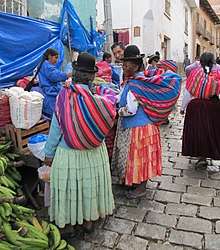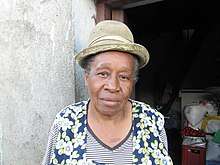Afro-Bolivians
Afro-Bolivians are Bolivian people of Sub-Saharan African heritage and therefore the descriptive "Afro-Bolivian" may refer to historical or cultural elements in Bolivia thought to emanate from their community. It can also refer to the combining of African and other cultural elements found in Bolivian society such as religion, music, language, the arts, and class culture. The Afro-Bolivians are recognized as one of the constituent ethnic groups of Bolivia by the country's government, and are ceremonially led by a king who traces his descent back to a line of monarchs that reigned in Africa during the medieval period. They numbered 23,330 according to the 2012 census.[1]
 An Afro-Bolivian woman dressed in traditional Andean clothing in Coroico | |
| Total population | |
|---|---|
| 23,330[1] | |
| Regions with significant populations | |
| Yungas | |
| Languages | |
| Spanish | |
| Religion | |
| Catholicism • Traditional | |
| Related ethnic groups | |
| West Africans, Central Africans, Afro-Latin Americans and Bolivians |
History of slavery in Bolivia
In 1544, the Spanish Conquistadors discovered the silver mines in a city now called Potosí, which is on the base of Cerro Rico (Rich Mountain) in Bolivia. Almost immediately, they began enslaving the natives as workers in the mines. However, the health of the natives working in the mines became very poor, which is why the Spanish began to look towards a new group for labor. By the beginning of the seventeenth century, the Spanish mine owners and barons began bringing in African slaves in high numbers to help work the mines with the natives who were still able.[2]
Slaves were put to work in difficult conditions. Some slaves working in the mines survived no more than a few months. Initially, the slaves were not used to working at such a high altitude. Many of these Native and African workers' lives were cut short because of the toxic smelter fumes and mercury vapors they inhaled while working the mines. Slaves worked in the mines for 4 months on average. As such they had to be blindfolded upon leaving the mines to protect their eyes, which had become adapted to darkness.
Although it was a requirement for Natives and Africans over 18 years of age to work in the mines for 12-hour shifts, younger children were still reputed to be put to work in the mines. These children worked fewer hours; however, they were still exposed to the same extremely harsh conditions of all the miners, including asbestos, toxic gases, cave-ins, and explosions. It is estimated that as many as eight million Africans and Natives died from working the mines between 1545, when the Spaniards first put the Natives to work, until 1825, the end of the colonial period.
The Spaniards' way of fortifying the slaves against the harsh conditions in the mines was to provide them with coca leaves to chew. Coca, a very important element of Bolivian culture, is an agricultural product consumed in Bolivia that can also be processed into cocaine. By chewing coca leaves, the slaves numbed their senses to the cold, as well as dampening the feeling of hunger and alleviating altitude sickness.
The Yungas
After their emancipation in the 19th century, Afro-Bolivians would relocate to a place called the Yungas. The Yungas, which is not far north from the city of La Paz, is where most of the country's coca is grown. In parts of the Yungas such as Coroico, Mururata, Chicaloma, Calacala-Coscoma, and Irupana are a large number of Bolivians of African heritage. Before the Bolivians relocated to the Yungas, it was a place mostly inhabited by indigenous Aymara people and mestizos (European and Native mixed people).
Keeping the culture
Although these Afro-Bolivians were free, they still had a difficult battle in trying to maintain their culture. Many elements of their culture began to disappear, such as their feast, language, and spiritual sense to name a few. They had to fight very strongly against the colonial aggression and exclusion of their post-emancipation culture. One of the ways that they were able to hold on to this culture was through their music and dance.
Saya music
The biggest African influence in Bolivian culture is Saya music or La Saya. Saya, which is growing in popularity in Bolivia, is still very misunderstood. The reason for this lack of understanding of saya is because the interpretation of the instruments as well as the rhythm is very peculiar. It involves Andean instruments incorporated with African percussion. The primary instrument is the drum, which was passed on by their African ancestors, along with gourds, shakers, and even jingles bells that are attached to their clothing on the ankle area.
During the performance of saya, the Afro-Bolivians wear Aymara style clothing. The women wear a bright multi-colored blouse with ribbons, a multi-colored skirt called a “pollera”, with a “manta” (back cover) in their hand, and a bowler hat. The men on the other hand, wear a hat, feast shirt, an Aymara style sash around the waist, woolen thick cloth pants called “bayeta pants”, and sandals.
Every rhythm of Saya begins with the beating of a jingle bell by the Caporal (foreman) who guides the dance. This Caporal (also called capataz) guides the dancers with a cudgel (whip) in hand, decorated pants, and jingle bells near the ankles. The women, who have their own guide during this dance, sing while moving their hips, shaking their hands, as well as dialoguing with the men who play the bass drum and coancha.
Afro-Bolivians today

Even though Bolivia had the richest silver mine in the world in the 17th century, it is currently the 2nd poorest country in South America. Most Bolivians live in rural areas, are unable to acquire basic needs, and depend on farming for their survival. In fact, it was reported at Bolivia's national referendum in 2004, that Afro-Bolivians (as well as the indigenous people) face discrimination, disadvantages in health, life expectancy, education, income, literacy, and work under brutal conditions.
It has been estimated that 25,000 Afro-Bolivians live in the Yungas. They are proud of their culture and have fought very hard to preserve it. In fact, in the town of Mururata, the Afro-Bolivians managed to maintain their traditional culture, to the point of maintaining a continuous Afro-Bolivian monarchy currently led by Julio Pinedo. Afro-Bolivians spread to the east in Cochabamba and Santa Cruz de la Sierra. In Santa Cruz there are more Afro-Brazilians than Afro-Bolivians. They are trying to put together African culture classes for the young people, in an attempt to maintain their African culture.
Despite the Afro-Bolivian community fervently working to preserve their culture, many Afro-Bolivians have reported experiencing severe racism and feelings of isolation from society due to intolerance. Laws that actually criminalize racism and discrimination in Afro-Bolivia have slowly been ratified as the first anti-discriminatory law (law 45) was passed in 2010 and was met with violent protesting and rioting. In 2009 President Evo Morales added amendments to the national constitution that outlined the rights of Afro-Bolivians and guaranteed the protection of such liberties. The amendments also generally extended to indigenous peoples and officially recognized Afro-Bolivians as a minority group in Bolivia despite them not being included in the national census three years later. In addition to the country's constitution being updated in 2009, President Morales created the Vice Ministry for Decolonization to create policies that criminalize racism while working to improve literacy and create better race relations in Bolivia.The Vice Ministry for Decolonization also works to dismantle colorism and racism influenced by European colonization while also promoting the philosophy of "intercultural-ity" in which citizens of the nation recognize every ethnic groups' traditions and cultural practices as contributions to society.
Notable Afro-Bolivians
- Leonel Morales, football player
- Augusto Andaveris, football player
- Marfa Inofuentes, afrobolivian activist
- Ramiro Castillo, football player
- Bonifacio Pinedo, Afro-Bolivian king
- Gustavo Pinedo, football player
- Julio Pinedo, Afro-Bolivian king
- Mónica Rey Gutiérrez, supranational delegate to the Plurinational Legislative Assembly of Bolivia
- Edemir Rodríguez, football player, currently playing for Club Bolivar
External links
References
- "Censo de Población y Vivienda 2012 Bolivia Características de la Población". Instituto Nacional de Estadística, República de Bolivia. p. 29.
- Afro-Bolivians Archived July 31, 2011, at the Wayback Machine
- https://www.casarealafroboliviana.org/fundamentos-juridicos.html